The Valley of the Kings is the site chosen by the later Pharohs to build their tombs so that grave robbers would not be able to identify where they lay. This is the city of the dead where 62 magnificent tombs have been discovered. Potentially hundreds were originally carved into the desert rocks, intricately painted with various minerals and stone dyes which have maintained their rich hues and are filled with treasures for use in the afterlife by many dynasties of the Pharaohs. The pyramids had been the tombs of the early Pharaohs and their contents had quickly disappeared. The Egyptians believed in the life hereafter. They only knew Egypt and so their construct of the universe was based on the fact that the sun which they worshipped, rose every day and set every night and, they determined, must after setting go under the earth to a river where a great battle took place with the underground devils only to rise successfully each morning. As each Pharaoh came to power, the construction of his tomb began, and depending on his lifespan, it would either be finished before his death, or not, and then work on the new Pharoh's tomb would begin. There is a geologically formed pyramid in the mountains at the top of the Valley of the Kings that foretells the choice of location, but the rock that was dug out of the tombs was used to "entomb" the tomb and disguise it's location, so the discovery of this area took centuries. The only intact tomb to this day, remains that of Tutenkamen.



Most disturbing is the widespread gasoline shortage which resulted in hours-long lineups for those lucky enough to have a vehicle, and hundreds of men with gas cans standing in every gas station we passed. In Luxor itself, we saw men demonstrating at one. Our guide told us the shortage started in Cairo, but had been contained there (not sure that is true) and was caused by the black market. He said people were buying more than they needed, and selling it on the black market. This obviously didn't make any sense as people usually only hoard when the supply is poor or they have little confidence that the supply is consistent. Egypt also produces most of its own oil. It is a startling picture to see a large man riding a donkey at full speed - and this was a picture we saw many, many times over.
This UNESCO world heritage site, forbids the use of cameras, presumably to protect the tombs, and we left them on the bus, as we proceeded into the area. The number of visitors per day, into each tomb is also tightly controlled. One just cannot comprehend how the construction and artwork of these tombs took place in this heat and in this desolate area - for there is not one green living thing here. We visited tombs, each one chosen to show either a completed one, an unfinished one, and in the case of Ramses III, one that had, during it's construction, run into another tomb and had to detour around it. It is quite cool inside the mountain, and each tomb is constructed the same, with a long tunnel that goes deep into the mountain. The walls and ceilings are finished smooth, unless of course incomplete, and covered every inch in hieroglyphics which do not tell a story, but instead tell the gods, why they should grant eternity to the Pharoh. The colored paints remain more noticeably on the ceilings - which are painted a deep cobalt blue with white stars, and the ochre, blues yellows are still evident in most. The splendour of these tombs in their original state, must have been breathtaking, and it is startling to see them so untouched and preserved after thousands of years. The skills of the artists who carved the details of the hieroglyphics so many centuries ago, is on display for all of us to see, so perfectly imagined and executed. They foreshadowed the temples we would see later in the day. Each tomb entry corridor eventually led to where the tomb was and only in the first one, was the tomb intact. It was a very large carved stone coffin, with a lid in a domed room.
Off to the Temple of Hatshepsut, the only female Pharoh in history. This building, carved into the mountain actually stuns you when you see it at first as it is so modern looking and it looks like it could be used today. It is magnificent. This Temple rises out of the desert in a series of brilliant white terraces. Hatshepsut was both a woman and a Pharoh. She dressed like a man and wore a false beard, due to the considerable bias against ruling females during that era. The mortuary Temple of Hatshepsut merges with the sheer limestone cliffs that surround it.


Then we went to Colossi of Memnon, which are two twin 64 foot immense statues of Amenhotep III that once guarded the entrance to Amenhotep's great temple.

We stopped at an Alabaster factory to see the men creating bowls and lanterns made of Alabaster.

By this point, we were having a very difficult time integrating the sheer scale of what was constructed here since 3000 BC. First of all that it exists in its present state is a wonder. Secondly, the difficulty of building these immense temples in this desert climate, where we were exhausted from just walking. The art work, like any art work, once you exam the details reveals both the extremely great talent of some, and the mediocrity of others, but when viewed holistically, it is just amazing.
After a 3 hour drive back to Safaga, we were relieved to have gotten back safely, and to have witnessed the marvel of what we saw in Luxor, but we were not alone, among our friends, in saying of all the countries we have visited on this cruise, this one left us feeling the saddest for the people.
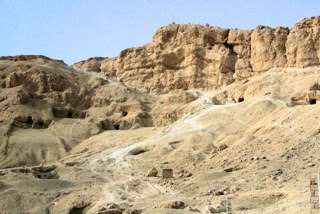






















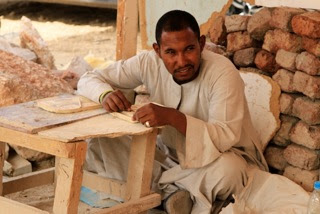


















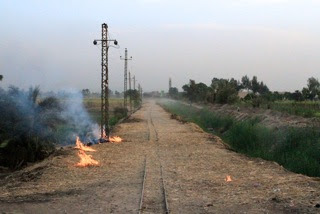






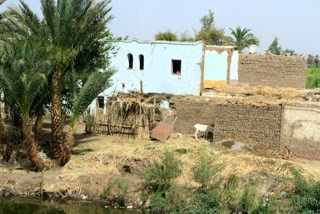





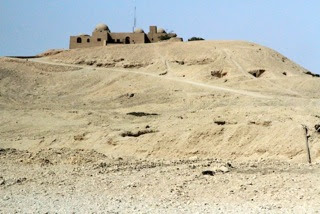



No comments:
Post a Comment